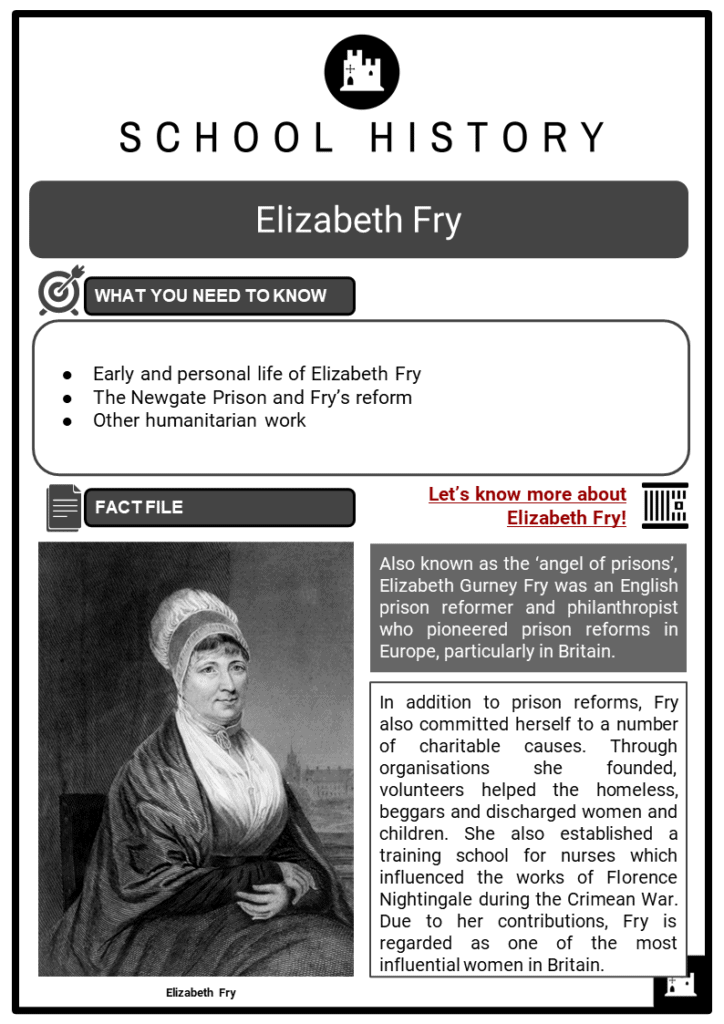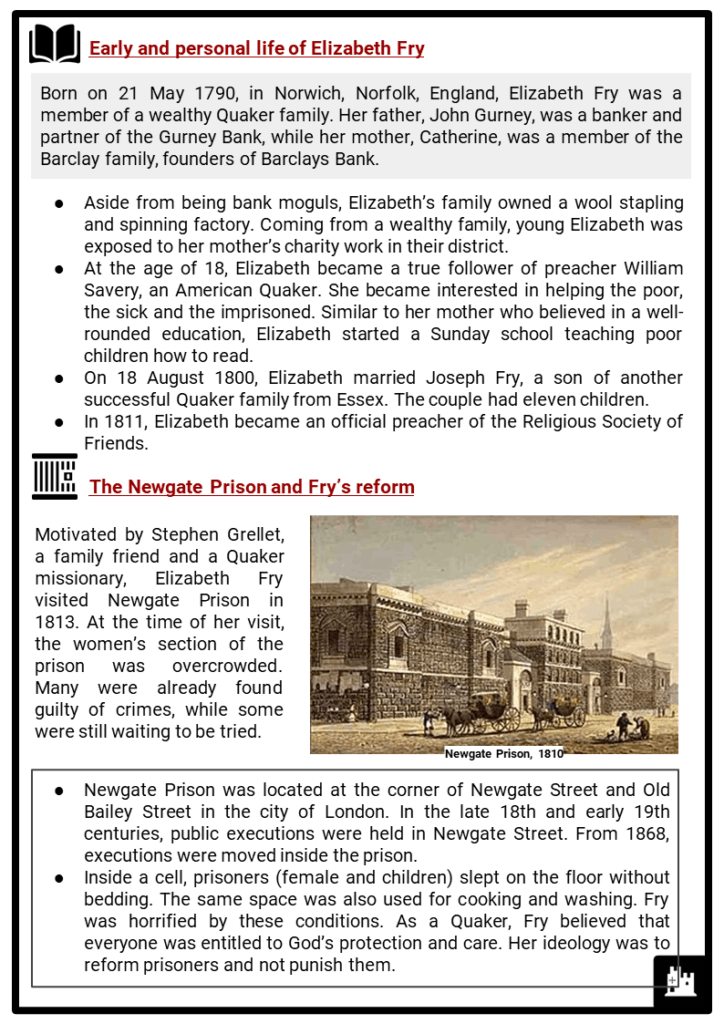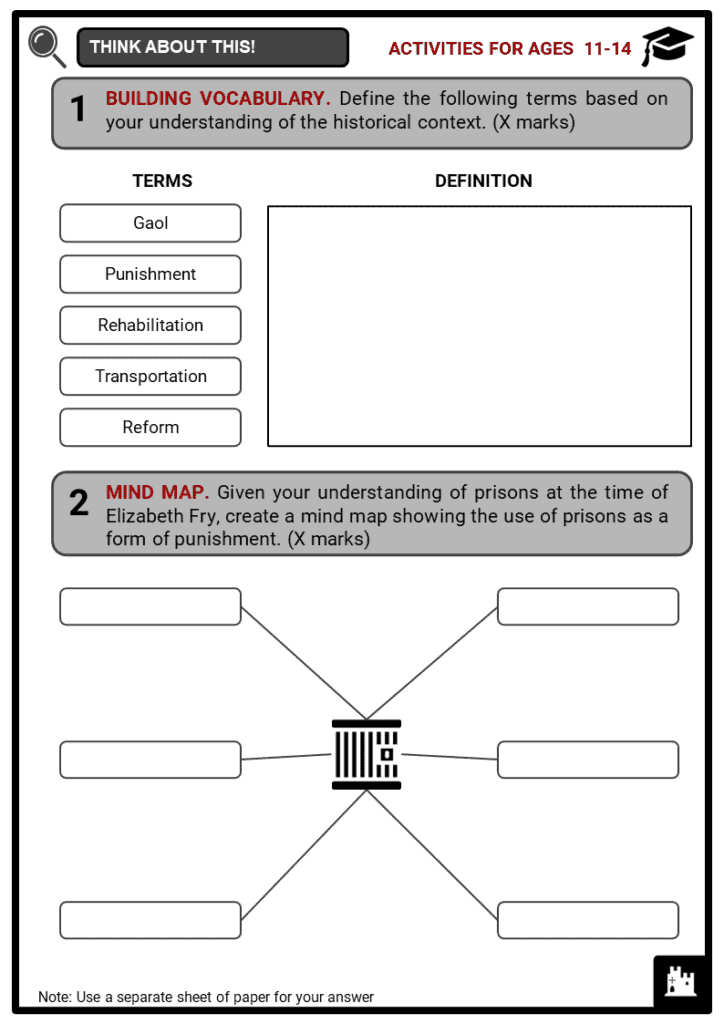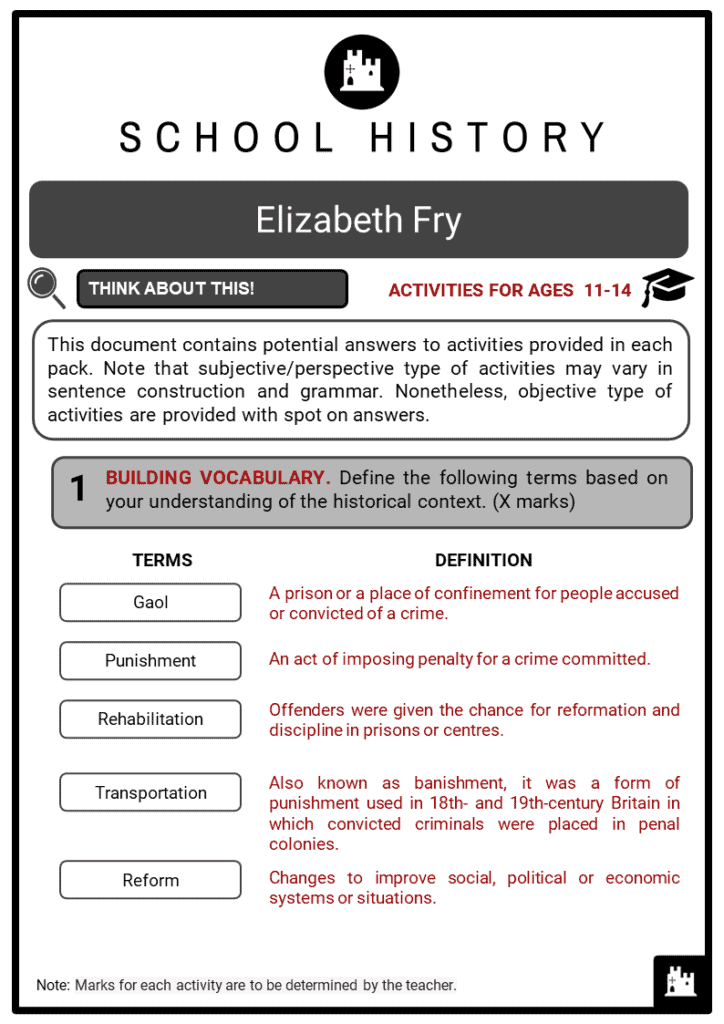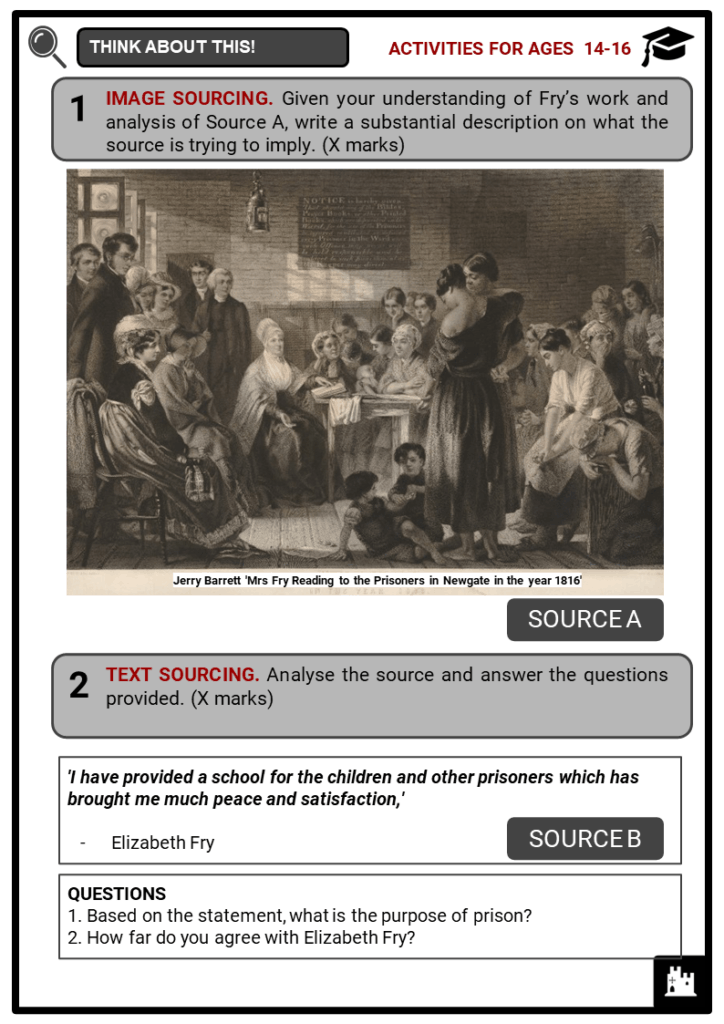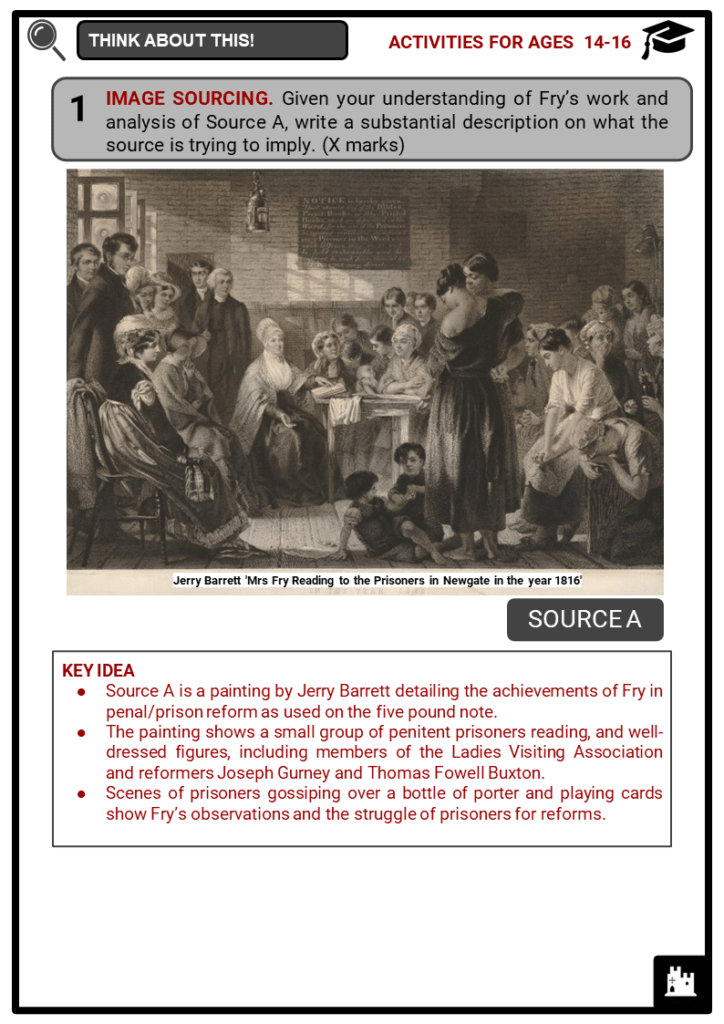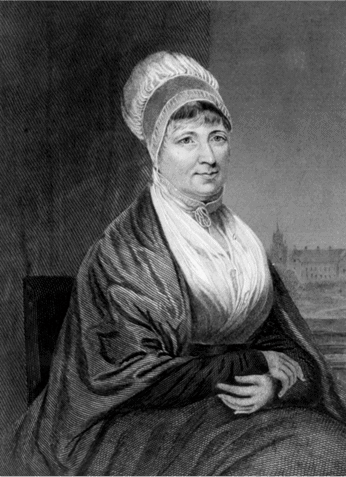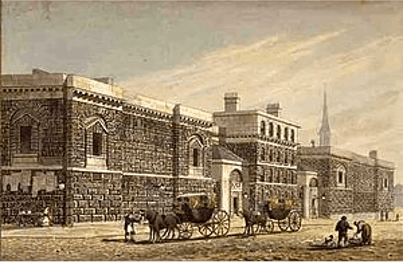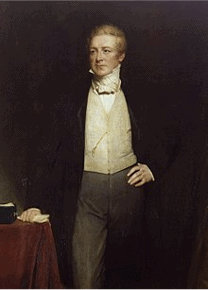Download Elizabeth Fry Worksheets
Do you want to save dozens of hours in time? Get your evenings and weekends back? Be able to teach Elizabeth Fry to your students?
Our worksheet bundle includes a fact file and printable worksheets and student activities. Perfect for both the classroom and homeschooling!
Table of Contents
Add a header to begin generating the table of contents
Summary
- Early and personal life of Elizabeth Fry
- The Newgate Prison and Fry’s reform
- Other humanitarian work
Key Facts And Information
Let’s know more about Elizabeth Fry!
- Also known as the ‘angel of prisons’, Elizabeth Gurney Fry was an English prison reformer and philanthropist who pioneered prison reforms in Europe, particularly in Britain.
- In addition to prison reforms, Fry also committed herself to a number of charitable causes. Through organisations she founded, volunteers helped the homeless, beggars and discharged women and children. She also established a training school for nurses which influenced the works of Florence Nightingale during the Crimean War. Due to her contributions, Fry is regarded as one of the most influential women in Britain.
Early and personal life of Elizabeth Fry
- Born on 21 May 1790, in Norwich, Norfolk, England, Elizabeth Fry was a member of a wealthy Quaker family. Her father, John Gurney, was a banker and partner of the Gurney Bank, while her mother, Catherine, was a member of the Barclay family, founders of Barclays Bank.
- Aside from being bank moguls, Elizabeth’s family owned a wool stapling and spinning factory. Coming from a wealthy family, young Elizabeth was exposed to her mother’s charity work in their district.
- At the age of 18, Elizabeth became a true follower of preacher William Savery, an American Quaker. She became interested in helping the poor, the sick and the imprisoned. Similar to her mother who believed in a well-rounded education, Elizabeth started a Sunday school teaching poor children how to read.
- On 18 August 1800, Elizabeth married Joseph Fry, a son of another successful Quaker family from Essex. The couple had eleven children.
- In 1811, Elizabeth became an official preacher of the Religious Society of Friends.
The Newgate Prison and Fry’s reform
- Motivated by Stephen Grellet, a family friend and a Quaker missionary, Elizabeth Fry visited Newgate Prison in 1813. At the time of her visit, the women’s section of the prison was overcrowded. Many were already found guilty of crimes, while some were still waiting to be tried.
- Newgate Prison was located at the corner of Newgate Street and Old Bailey Street in the city of London. In the late 18th and early 19th centuries, public executions were held in Newgate Street. From 1868, executions were moved inside the prison.
- Inside a cell, prisoners (female and children) slept on the floor without bedding. The same space was also used for cooking and washing. Fry was horrified by these conditions. As a Quaker, Fry believed that everyone was entitled to God’s protection and care. Her ideology was to reform prisoners and not punish them.
- The following day, Fry returned to Newgate with food and clothes for some of the prisoners. She visited the women’s section of the prison on a regular basis until her family started facing financial difficulties. The 1812 financial panic in the city of London affected both her husband and parents’ business.
- After nearly four years, Fry returned to the prison. Fry believed that sexual abuse was being committed by the male wardens against the female prisoners.
- She set up prayer groups for the female prisoners and organised a school for their children. Moreover, she supervised educational programmes in the prison, allowing the women to learn useful skills such as sewing and knitting in order to improve their chances of finding employment when released, and in doing so avoid prostitution.
- In April 1817, she formed the Association for the Improvement of Female Prisoners. This group aimed to separate prisoners based on sex and type of crimes committed. Furthermore, it proposed female supervision for female prisoners. Her work was later copied which eventually gave way to the creation of the British Ladies’ Society for Promoting the Reformation of Female Prisoners in 1821.
- In addition to Newgate, Fry also visited prisons in Scotland and Northern England. In 1827, she also went to detention houses in Ireland.
- Similar to the work of Fry, several social reformers such as Hannah Beaven, Elizabeth Pryor and Katherine Fry (daughter of Elizabeth Fry) visited transport ships.
- Along with Fry, they also campaigned for the welfare of prisoners being transported to penal colonies. Instead of being exposed in open carts through the streets of London, Fry persuaded the Governor of Newgate to send women convicts in closed carriages.
- Moreover, she requested captains to ensure that women and children could at least receive a share of food and water on the journey. A Bible and string were added to their vital care package.
- About 106 transport ships were visited by Fry. Her work contributed to the beginning of the abolition of the transportation movement in Britain. Despite the end of transportation as a means of punishment in 1837, Fry continued to visit transportation ships until 1843.
- After the election of her brother-in-law, Thomas Fowell Buxton, to parliament, Fry’s observation of prisons was heard by the House of Commons committee.
- In addition to more humane conditions in prisons, Fry and her brother John Gurney also pushed for the abolition of capital punishment. At that time, the Bloody Code was prevalent in Britain, making over 200 crimes punishable by death.
- When Sir Robert Peel became Home Secretary in 1822, Fry’s reforms gained a bigger audience. As Home Secretary, Peel reduced the type of crimes punishable by death. Known as the Peel’s Acts, he repealed criminal statutes and simplified the law.
- Utilising Fry’s suggestions for prison reform, the Gaols Act was passed in 1823.
- The 1823 Gaols Act provided payment for gaolers, which was previously paid out by prisoners themselves. It also separated male and female prisoners. Female prisoners were also supervised by female wardens. The act also prohibited the use of irons and manacles as punishment.
- In 1827, the Observation on the Visiting, Superintendence and Government of Female Prisoners was published. In her work, Fry put emphasis on the need for prison reforms to rehabilitate and provide new opportunities for female convicts. Much of her work clearly condemned the death penalty.
- In addition to Peel, Queen Victoria was also a supporter of Fry. In addition to several audiences, the queen also contributed money to her cause.
- Due to her contributions to prison reforms, Elizabeth Fry’s portrait on the £5 note was in circulation in the years 2002-2016.
Other humanitarian work
- In addition to prison reforms, Fry also helped the homeless and servants. Her work instituted reforms in workhouses and hospitals.
- Through the establishment of ‘nightly shelters’, Fry offered temporary shelter for the homeless in London. She instituted the Brighton District Visiting Society, which visited the poor and provided help. This volunteer-based organisation was duplicated in other towns throughout Britain.
- In 1825, she formed a Servant’s Society. By 1835, a separate District Visiting Society was created to provide aid to the poor and beggars.
- Fry was also an active and strong supporter of the abolition of slavery.
- In 1840, Fry opened a training school for nurses in 1840. Her work became an inspiration to Florence Nightingale who later introduced reforms in patient care and hospitals. Some of Fry’s nurses were included in Nightingale’s team who went to Crimea.
- Following Fry’s death in 1845, the Lord Mayor of London became instrumental in the establishment of a temporary shelter for discharged women and children from metropolitan goals. Funded by private companies and individuals, the shelter opened in 1849.
Image sources:

